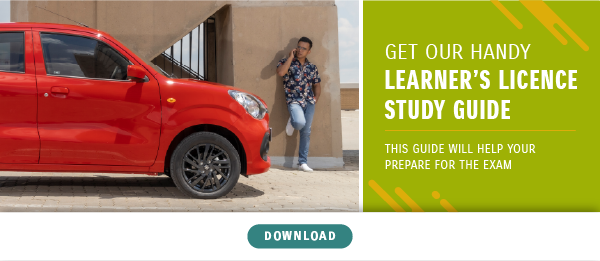 There are simple tactics you can take note of that can help you avoid most accidents, whether fender-benders or fatal crashes.
There are simple tactics you can take note of that can help you avoid most accidents, whether fender-benders or fatal crashes.
While there are many reasons for car accidents, you can only be prepared for situations that you have control over. It’s a comfort to know that all of Suzuki’s vehicles are tested at recognised international testing facilities and comply with the regulations of their relevant country. In the RTMC’s (Road Traffic Management Corporation) 2018 report, vehicle fault is only recorded as the cause of 4,2% of fatal accidents. However, in the same report, the RTMC describes human factors as the driving reason for 89,3% of all fatal road accidents. The statistic is shocking, and yet is a strong motivator to be better prepared for road safety, which is why we have put together our top six ways for staying safe on the road. While there are many reasons for car accidents, you can only be prepared for situations that you have control over. It’s a comfort to know that all of Suzuki’s vehicles are tested at recognised international testing facilities and comply with the regulations of their relevant country. In the RTMC’s (Road Traffic Management Corporation) 2018 report, vehicle fault is only recorded as the cause of 4,2% of fatal accidents. However, in the same report, the RTMC describes human factors as the driving reason for 89,3% of all fatal road accidents. The statistic is shocking, and yet is a strong motivator to be better prepared for road safety, which is why we have put together our top six ways for staying safe on the road.
Estimated reading time: 4 minutes, 42 seconds.
While there are many reasons for car accidents, you can only be prepared for situations that you have control over. It’s a comfort to know that all of Suzuki’s vehicles are tested at recognised international testing facilities and comply with the regulations of their relevant country. In the RTMC’s (Road Traffic Management Corporation) 2018 report, vehicle fault is only recorded as the cause of 4,2% of fatal accidents. However, in the same report, the RTMC describes human factors as the driving reason for 89,3% of all fatal road accidents. The statistic is shocking, and yet is a strong motivator to be better prepared for road safety, which is why we have put together our top six ways for staying safe on the road.
Six ways to stay safe on the road
1. Comply with the servicing requirements in your car’s manual
Yes, reading your car’s manual and then applying what you read can keep you safer because it highlights the specifics about servicing your car. For example, it will tell you what tyres to use, and where you can use them, how regularly your car needs to be serviced, where the fuses are and how to replace them, and general tips on maintaining your car so that it performs optimally at all times.
2. Maintain your wheels
Ensure that you regularly check the tread on your tyres (a quick check is to put a matchstick flat in the tread—if it stands proud, the tyres should be changed).
Check your tyre pressure at regular intervals. Ensure that your tyre pressure is correct by having the petrol attendant check the pressure as often as you fill up (or every second time). You can check the recommended tyre pressure by looking at the sticker in the door jamb of your car. There are many fringe benefits of ensuring your tyres are properly inflated which include experiencing a smoother and quieter ride as well as making your tyres last longer by wearing more evenly but the biggest benefit is for your safety. Driving with properly inflated tyres will ensure that your tyres have the best possible grip when cornering, accelerating or braking.
If you experience a vibration when driving in a straight line, then have the wheel alignment and balancing checked by an authorised tyre supplier. During this balancing, the rims can be examined for external damage, which may be due to hitting potholes, and it may be recommended to change the wheel.
Tyres should be rotated front to back every 10,000kms (this can be facilitated at your nearest authorised Suzuki Auto dealership). Contact your nearest dealer to make your appointment.
3. Hold the steering wheel correctly
While you may have been told trasitionally that your hands should be placed at 10h00 and 14h00, always with both hands on the steering wheel. Which was said to give you maximum control in all circumstances. This may actually be dangerous in the event of an accident as the airbags may cause damage to your arms. Some research has shown that this position, while good for maintaining a steady grip on the steering wheel has been replaced with the technique now knowns as 9 and 3.
The technique for proper placement of your hands on the steering wheel has changed dramatically over the years but it is most often described in terms of how the placement of your hands relates to numbers on a clock. National Highway Transport Safety Administration (NHTSA) in the USA now recommends the technique known as 9 and 3. Place your left hand on the left portion of the steering wheel in a location approximate to where the nine would be if the wheel was a clock. Your right hand should be placed on the right portion of the wheel where the three would be located. These recommendations are quite flexible, but keep in mind that 2 and 10 o’clock is no longer recommended because it can be dangerous in vehicles with smaller steering wheels and equipped with airbags.
In the event of unusual circumstances (slippery or bumpy roads), the behaviour of the vehicle can be felt and controlled through the steering wheel, which is when it is most vital to keep both hands in their correct positions.
4. Always check blind spots and mirrors
As cliche a safety tip as it is, it holds true. Always be aware of who and what is around you, especially before changing or joining lanes.
Make sure you know where your blind spots are.
5. Drive carefully on wet roads
The first rainstorms of a season tend to stir up oil and diesel, which can make the roads slippery, so make sure you keep a safe following distance. The Automobile Association recommends making it five or six seconds (or five to six car lengths) when the weather is bad.
Always put lights on to make your vehicle visible in these conditions.
6. Always exercise caution
Don’t drink and drive. Don’t call or message and drive. Don’t speed. In short, follow the laws of the road.
Always be mindful of pedestrians.
The K53 driving system was designed with driver and passenger safety in mind on the road, so use what you learned while studying for your driver’s licence.
Cruise control is designed for comfort and ease on a straight, long road, such as a highway. It has safety features built in to give control of the vehicle back to the driver, such as pressing the brake or clutch, or if more power is required on a steep hill. However, it is vitally important to keep both hands on the steering wheel and concentrate fully while using cruise control.
Road safety is no joke, as the 12 503 fatal car accidents in 2019 reveal. But, it is comforting to know there are steps you can take to ensure you are as safe as possible on the road. If you’d like to know more about protecting yourself while driving, read our extensive driver protection and safety ebook .
While it is always best to try to avoid a car accident, they are called accidents for a reason - they may not be your fault and they can happen no matter how cautious you are. Revise the rules of the road by downloading our learner's licence study guide.


![Don't panic! Here's what to do in an accident [checklist]](https://blog.suzukiauto.co.za/hubfs/Suzuki.png)

